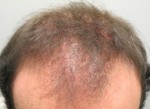These days, more and more men who want to compete in the marketplace are seeking cosmetic surgery because they see it as giving them a competitive advantage.
With over 35 million American men affected by hair loss, it’s not surprising that hair restoration ranks high on the list of most popular procedures, generating two billion dollars in revenue each year.
Forty two year-old New York composer Ken Gold started losing his hair 20 years ago.
Ken Gold: In your 20s, you know, everyone is more image-conscious and you don’t want to lose your hair in your 20s.
Ken is not alone. 20% of men in their 20s experience hair loss. In their 30s, the odds jump to 30%, and by the time a man is in his 50s, there is a 50% chance he will be losing some hair.
Ken Gold: Once you’ve lost your hair, you look older. And you don’t want to be 22 and look 35, you know?
Determined to stay youthful, Ken investigated his options and decided to undergo a series of hair transplant procedures beginning in 1981.
Ken Gold: One of the guys I was doing business with, he had a very thick full head of hair. And he said, “Well, I’ve got a hair transplant,” and I was just astonished.
But after five years and four painful, expensive procedures, Ken still didn’t have the full head of hair he wanted.
Ken Gold: My head was a mess. You only had to lift up the hair in the back and you could see what they call the Swiss cheese scalp, just this huge massive scar tissue with little round holes, you know.
Dr. Bernstein: When hair transplants were first started, they thought in order to get enough fullness, you had to move the hair in large clumps, and that’s traditionally known as plugs. And much of our practice is still devoted to hair transplant repair.
Ken despaired of ever finding the solution to his problem until he found the New Hair Institute in Fort Lee, New Jersey.
Dr. Bernstein: When I first saw Ken in 1995. He still had the traditional plugs, and I would say on a scale of one to ten, he was maybe a seven, with ten being the worst. We performed a procedure called follicular unit transplantation where hair is transplanted in exactly the way it grows in nature, which are little tiny groups of one to four hairs.
Ken Gold: After the first surgery I was just ecstatic because I was actually able to look at myself in the mirror.
Almost 20 years and $40,000 later, Ken has finally achieved the natural-looking hair he wanted. But there are alternatives to hair transplant surgery.
Dr. Bernstein: Probably the best thing to do if you’re noticing hair loss is to have a diagnosis of male pattern hair loss to make sure there is not some other treatable condition, and then to use a medication, such as Propecia, which actually can prevent hair loss if it is taken early enough.
But Ken Gold is convinced he’s found the right solution for him.
Ken Gold: I’m very happy now. I wasn’t happy five years ago. When I look in the mirror now, I see someone with hair and I’m able to comb it back and say, yeah, this looks okay.


 LPP in Male Pattern Alopecia
LPP in Male Pattern Alopecia The Discovery Channel interviews Dr. Bernstein for a piece on
The Discovery Channel interviews Dr. Bernstein for a piece on 



